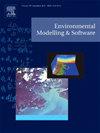通过估算河流地形深度面改进大陆和全球尺度数字高程模型
IF 4.8
2区 环境科学与生态学
Q1 COMPUTER SCIENCE, INTERDISCIPLINARY APPLICATIONS
引用次数: 0
摘要
当代大陆和全球尺度数字高程模型(dem)不是一个复合的地形测深面,因为它们往往缺乏测深。在这项研究中,我们分析了是否可以使用全球水文模型和简单的稳态水力技术来改善大陆和全球尺度的dem。我们使用了两个DEM数据集,全球可用的流量估计,以及简单的水力和制图软件来进行分析。我们分析了估算水深的两种不同方法:使用岸高和岸流量估算,使用水面高度(WSE)和基流估算来估算水深。我们还介绍并研究了一种在估计水深之前对DEM进行预清洗的新方法。我们发现,使用全球水文模型的流量和简单的水力分析,通过使用DEM的WSE估计和基流来估计地形水深面,可以持续减少DEM的误差和偏差。本文章由计算机程序翻译,如有差异,请以英文原文为准。

Improving continental and global scale digital elevation models via estimation of a riverine topobathymetric surface
Contemporary continental and global-scale digital elevation models (DEMs) are not a composite topobathymetric surface, as they tend to lack bathymetry. In this study, we analyzed if continental- and global-scale DEMs can be improved using a global hydrologic model and simple steady-state hydraulic techniques. We used two DEM datasets, globally available streamflow estimates, and simple hydraulic and mapping software to perform the analysis. We analyzed two distinct means by which to estimate bathymetry: the use of bank elevations and bankfull discharge estimates and the use of water surface elevation (WSE) and baseflow estimates to estimate bathymetry. We also introduced and investigated a new method for pre-cleaning the DEM prior to estimating a bathymetry. We found that the error and bias of a DEM can consistently be reduced using a global hydrologic model's streamflow and simple hydraulic analysis by using the DEMs WSE estimate and a baseflow to estimate the topobathymetric surface.
求助全文
通过发布文献求助,成功后即可免费获取论文全文。
去求助
来源期刊

Environmental Modelling & Software
工程技术-工程:环境
CiteScore
9.30
自引率
8.20%
发文量
241
审稿时长
60 days
期刊介绍:
Environmental Modelling & Software publishes contributions, in the form of research articles, reviews and short communications, on recent advances in environmental modelling and/or software. The aim is to improve our capacity to represent, understand, predict or manage the behaviour of environmental systems at all practical scales, and to communicate those improvements to a wide scientific and professional audience.
 求助内容:
求助内容: 应助结果提醒方式:
应助结果提醒方式:


